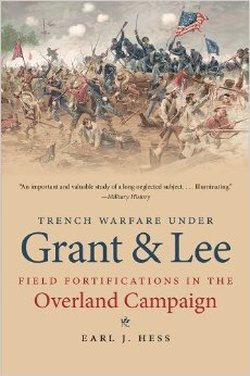
Earl J. Hess
The University of North Carolina Press, 2007, 313 pp., $26.00
ISBN: 978-1-4696-0994-2
Image courtesy of amazon.com
Earl J. Hess has sought out to perform a duty which is not quite researched in the American Civil War: he has written great academic works on field fortifications in the conflict. The reason this work should be hailed is due to the painstaking detail he places in the work and the amount of research he has performed. Trench Warfare Under Grant and Lee is the second book in the series he has written about field fortifications and while it is incredibly different from the first work, it shines even greater. Many works have been written about the Overland Campaign, but none have ever devoted themselves to the development of the warfare around the use of the trenches. In all honesty, these studies of trench warfare are usually written about when analyzing World War One, but Hess proves that the use of the trench was more prevalent during this campaign than any other.
Earl J. Hess is an associate professor of history at Lincoln Memorial University and has authored other works such as The Civil War in the West: Victory and Defeat from the Appalachians to the Mississippi and Pickett’s Charge – The Last Attack at Gettysburg. His book on Pickett’s Charge was the winner of the 2001 James I. Robertson Jr. Prize from the Civil War Library and Research Center. The first in the series on fortifications was Field Armies and Fortifications in the Civil War: The Eastern Campaign and the final work in the series is In the Trenches at Petersburg: Field Fortifications and the Confederate Defeat.
Much like his first work, he separates the book into the many different battles which occurred during the Overland Campaign. Instead of spanning years as he did in his first work, he has matter of months to write about. In each chapter, he analyzes the types of trenches and or field fortifications used by the armies along with the evolution of the tactics being used in order to combat the types of fortifications or trenches. When talking about battles specifically, there are moments when he breaks up the narrative into the days of attacks which, in many cases, have changes in the tactics used against them. In his account on the Battle of the Wilderness, he breaks up the action into certain days and it is quite amazing how the tactics change. His work is also aided by the use of maps which are drawn with such simplicity as to understand how the trenches are working in this regard. There are many works where the maps attempt to show the rises and falls in the terrain, but here, the map is laid out for complete understanding. That is not to say that the maps are not detailed, but they are not over-detailed as in other works. Also as part of the work, there are pictures on the types of fortifications and trenches used. As with his first work in the series, this was a great aid into understanding what was being described. Throughout the text, there are plenty of examples as to the types of trenches and fortifications and are usually always aided by a photograph or drawing. This type of detail and expertise is greatly appreciated in this work.
Earl J. Hess has proven that he is a master at writing about field armies and fortifications from his first book and now has proven himself even more by writing about the trenches. I highly recommend this book to any Civil War historian. There is a general study that most of the great fighting is done by the infantrymen while there is quite a lot the corps of engineers does for bringing about the victories on the battlefield. The narrative is flowing and easy to follow which is always a positive advantage in a work such as this. The terms being used can often confuse the Civil War novice, but in this work, Hess does a fantastic job ensuring the reader’s understanding of what is going on. In conclusion, I am greatly looking forward to reading the last work in the series and I applaud Earl J. Hess in the study which he has brought to light here. Highly Recommended!
 RSS Feed
RSS Feed
